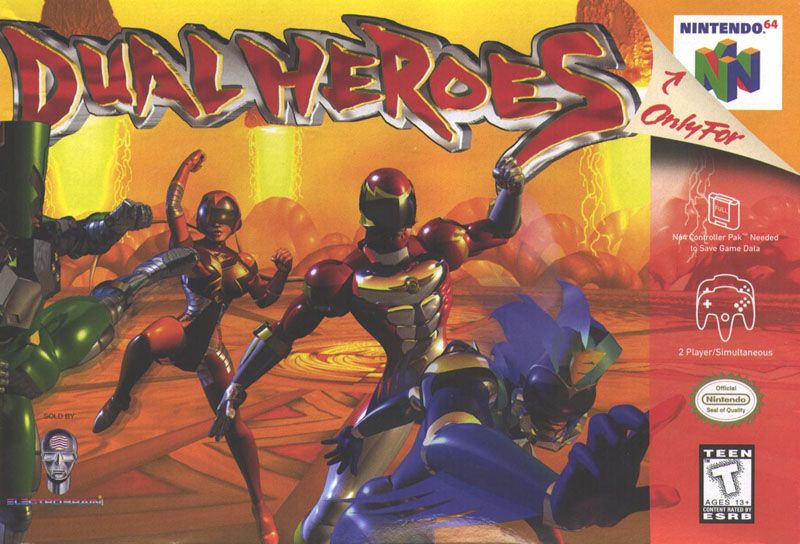Retro Replay Review
Gameplay
Dual Heroes drops you into fast-paced, one‐on‐one battles where each of the eight fighters brings a distinct arsenal of punches, kicks, and special moves. Learning the nuances of every character’s combo strings is essential; novice players will appreciate the straightforward button layout, while veterans can delve into frame‐perfect counters and air juggles. The core fighting mechanics feel responsive, and executing a well‐timed counter can shift momentum in an instant.
(HEY YOU!! We hope you enjoy! We try not to run ads. So basically, this is a very expensive hobby running this site. Please consider joining us for updates, forums, and more. Network w/ us to make some cash or friends while retro gaming, and you can win some free retro games for posting. Okay, carry on 👍)
One of Dual Heroes’ standout features is Robot Mode, where you effectively teach a customizable automaton how to fight in your preferred style. Between matches, you assign preferred combos and defensive routines, then send your robot into the ring against CPU opponents. Watching your creation adapt to enemy patterns adds a strategic layer beyond the usual memorization of AI quirks.
For those looking to forge a personal rivalry, the “Virtual Enemy” system lets you pick five opponent personas. Each of these challengers develops over successive bouts, learning from your tactics and evolving as a foil to your own skills. This dynamic twist keeps single‐player runs fresh and tests your ability to stay unpredictable.
The inclusion of local two‐player battles rounds out the package, offering classic couch competition. Matches are quick to set up and run smoothly even when both fighters unleash flashy super moves. While there’s no online component, the immediate feedback and trash‐talk potential make for memorable head‐to‐head sessions.
Graphics
Visually, Dual Heroes strikes a balance between crisp character models and colorful, if slightly minimalistic, stage backgrounds. Each fighter is rendered with distinct silhouettes and vibrant costume palettes, making it easy to recognize opponents in the heat of battle. Facial animations during taunts and victory poses inject personality without feeling overdone.
Stages range from neon‐lit urban rooftops to dusty dojo interiors, each with subtle environmental details like swaying banners or flickering spotlights. Though textures can appear dated under close inspection, the overall presentation leverages bold colors and smooth motion to keep the action legible at all times.
Special effects—such as energy blasts, shockwaves, and impact sparks—pop off the screen, lending a sense of weight to powerful strikes. Frame rate remains steady even when the battlefield is awash with flashy particle effects, ensuring that responsiveness is never sacrificed for spectacle.
That said, some visual flourishes feel repetitive after extended play. Background elements loop noticeably, and lighting effects don’t always react dynamically to move sets. Still, the aesthetic choices support the game’s arcade‐style feel and contribute to the overall excitement of each encounter.
Story
Dual Heroes’ narrative is minimal by modern standards, functioning mostly as a backdrop to the fighting. Each character has a brief biography explaining their motivation—whether it’s earning glory, seeking revenge, or perfecting martial arts. These snippets set the stage but rarely develop beyond tabletop summaries.
The Virtual Enemy system adds a pseudo‐campaign structure: selecting five AI contenders means following a loose progression as you climb a personalized ladder. Your chosen rivals react to your playstyle, taunt you between rounds, and even alter their move preferences, creating an emergent storyline born from gameplay rather than cutscenes.
Robot Mode similarly gifts a narrative hook: you’re a trainer crafting an ultimate fighting machine. While there’s no deep lore explaining how the robots were designed or the world they inhabit, the sense of personal investment comes from shaping your creation and unveiling its strengths in the ring.
Though fans of robust story beats may find the presentation thin, the game’s emphasis on rivalries and customization compensates. The framework encourages replayability, as you’re driven to refine your character’s tale through won bouts rather than scripted plot turns.
Overall Experience
Dual Heroes presents a compelling package for fighting‐game enthusiasts seeking quick, action‐packed sessions with a twist. The core mechanics are tight and rewarding, allowing both newcomers and seasoned players to find satisfaction in learning intricate move sets and perfecting defensive timing.
The game’s unique training modes—Robot Mode and Virtual Enemies—inject longevity by letting you cultivate personal challenges. Rather than simply climbing a static arcade ladder, you face adaptable foes that reflect your own habits, ensuring that every match can feel like a fresh test of skill.
Graphically, Dual Heroes leans into an arcade aesthetic that holds up well in local multiplayer, though it occasionally shows age in texture work and background loops. Still, the high‐impact effects and smooth frame rate underscore the developer’s focus on clarity and excitement during battle.
In sum, Dual Heroes is an engaging, solidly built fighter that shines brightest when enjoyed with friends or through its inventive AI‐training features. While it lacks an intricate storyline or online play, its blend of strategy, arcade flair, and head‐to‐head competition makes it a worthy contender for anyone looking to duke it out in style.
 Retro Replay Retro Replay gaming reviews, news, emulation, geek stuff and more!
Retro Replay Retro Replay gaming reviews, news, emulation, geek stuff and more!





Reviews
There are no reviews yet.